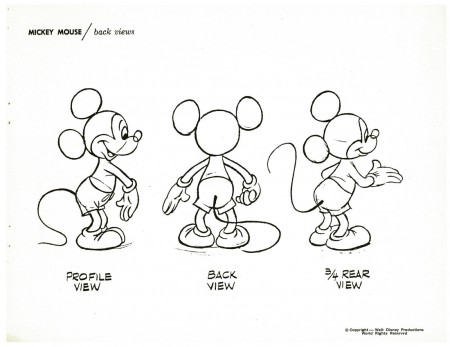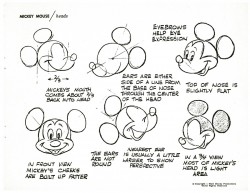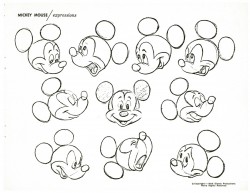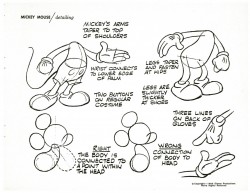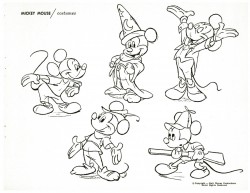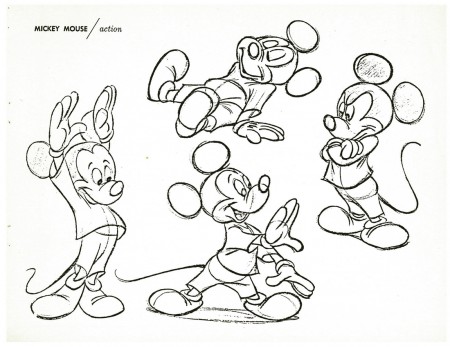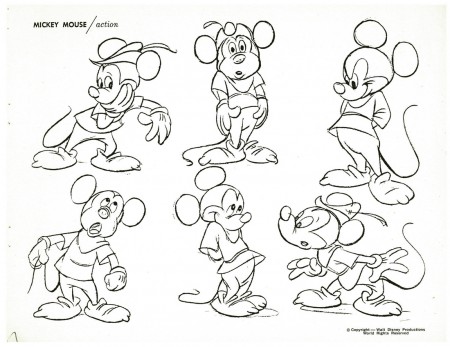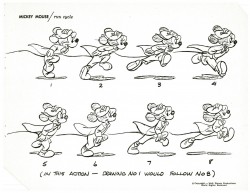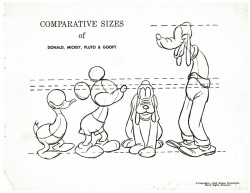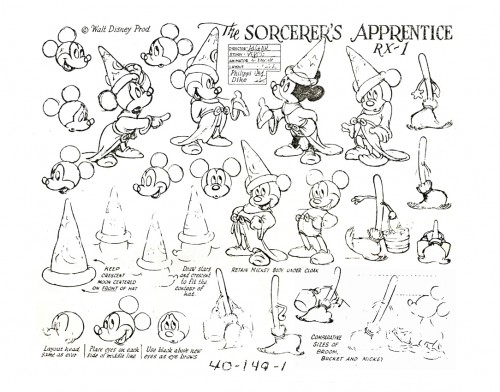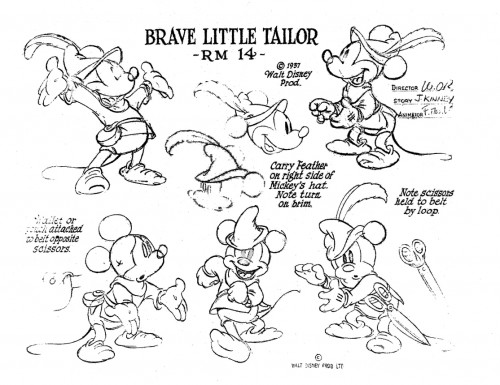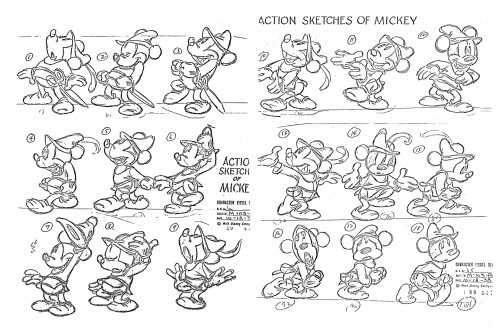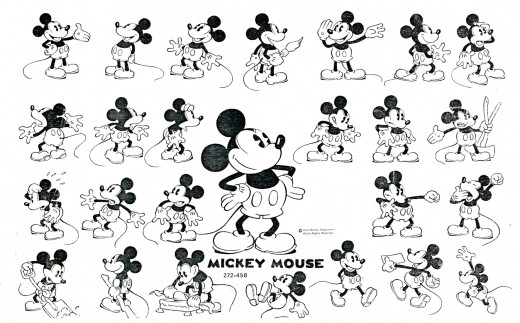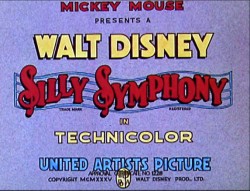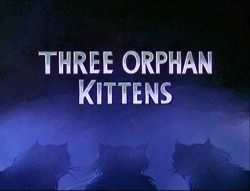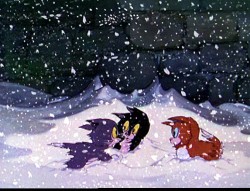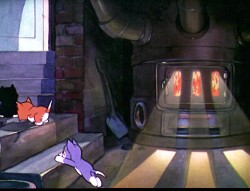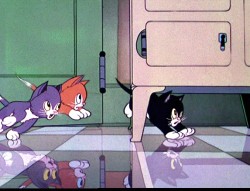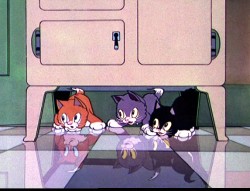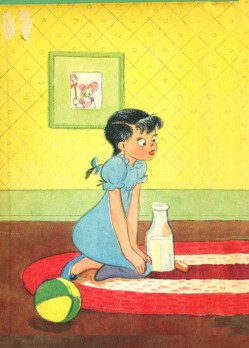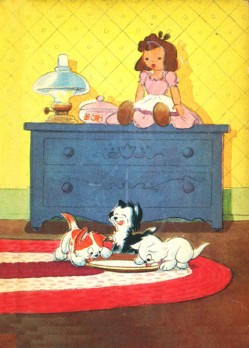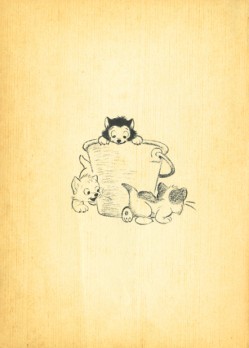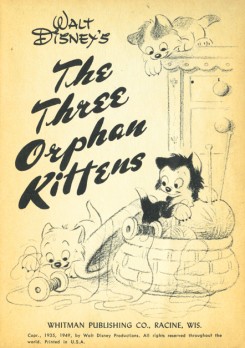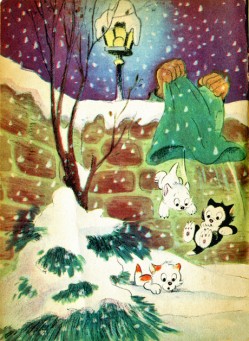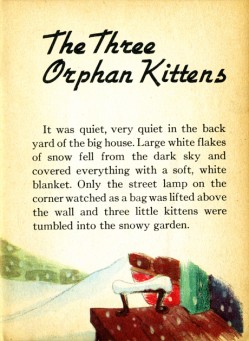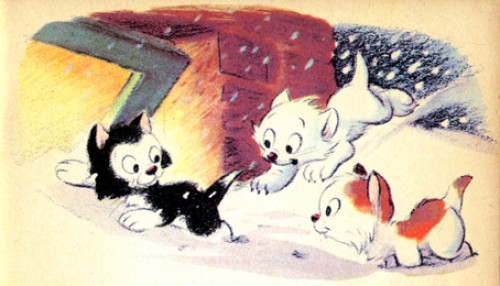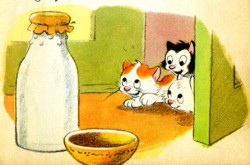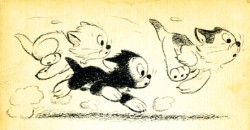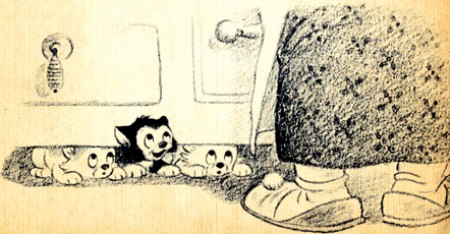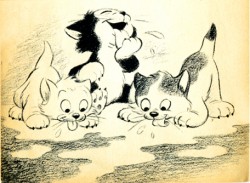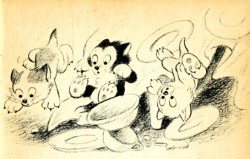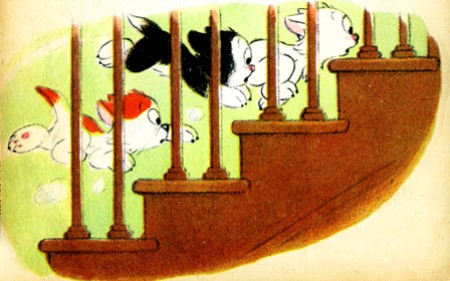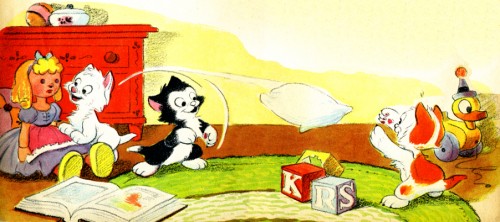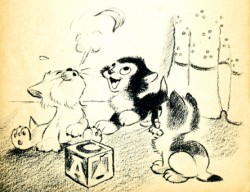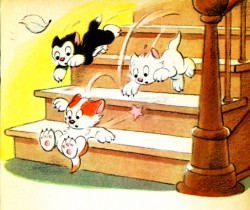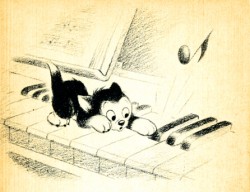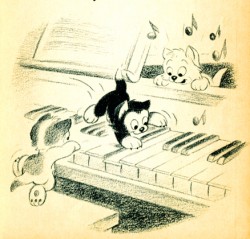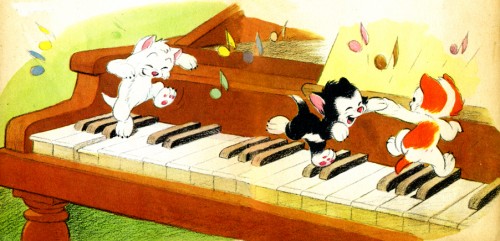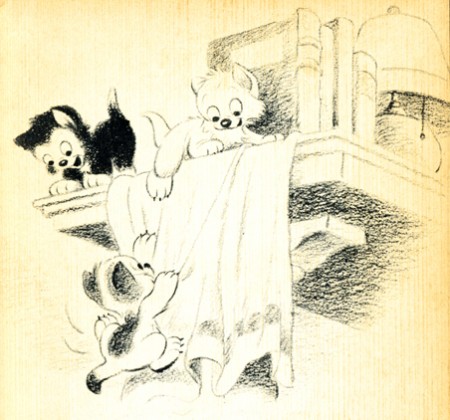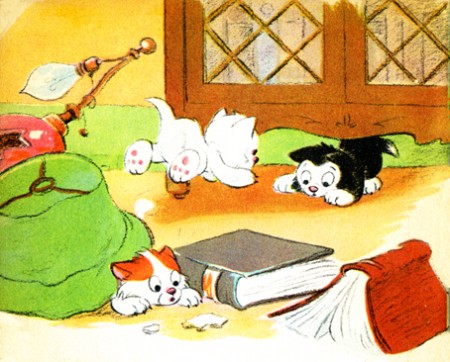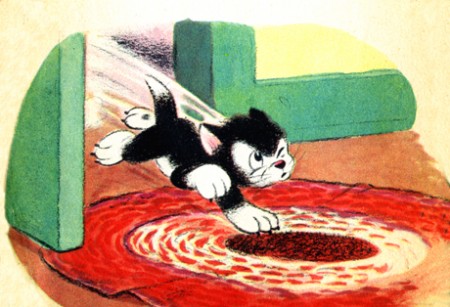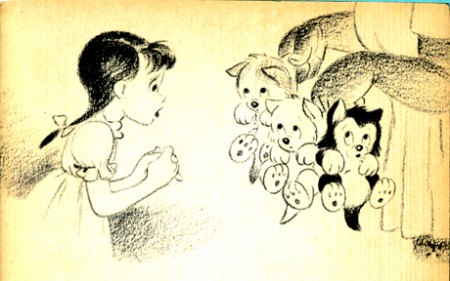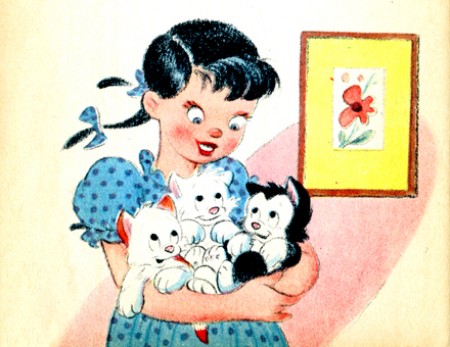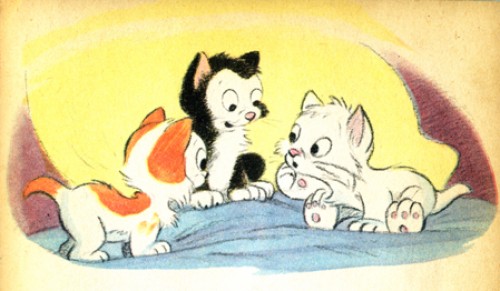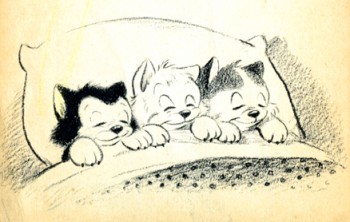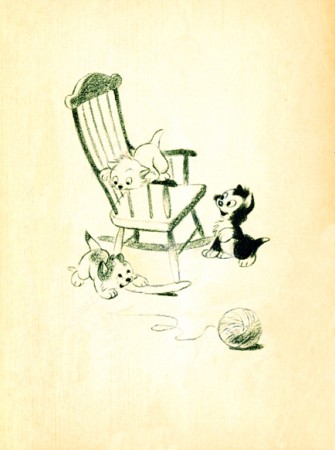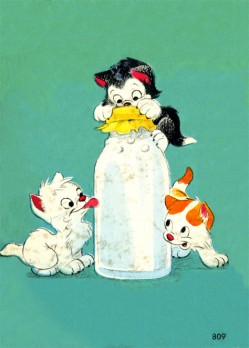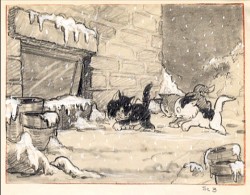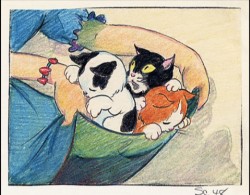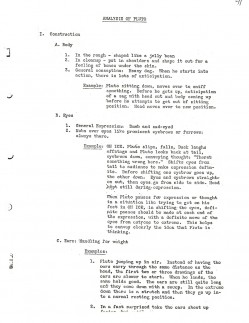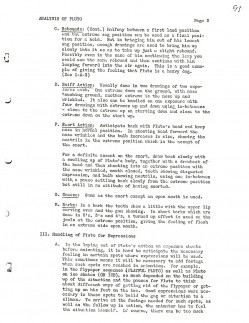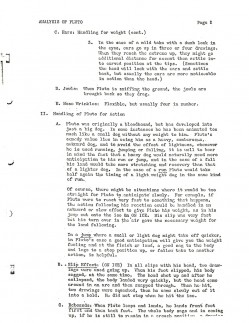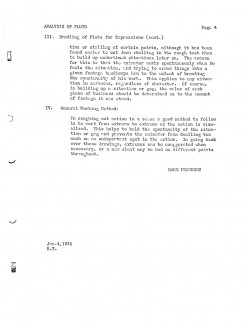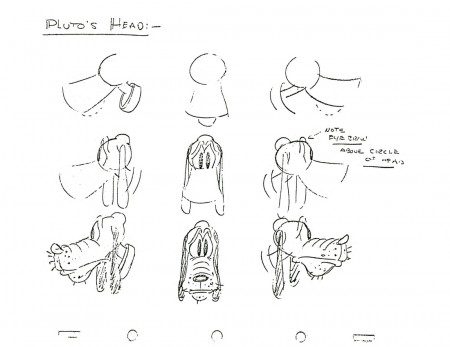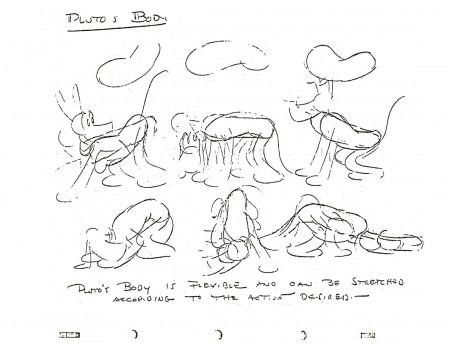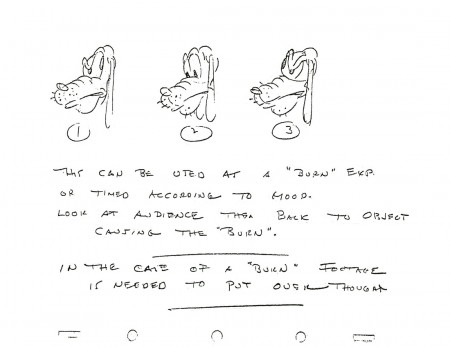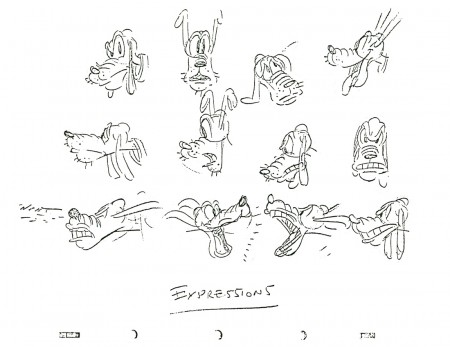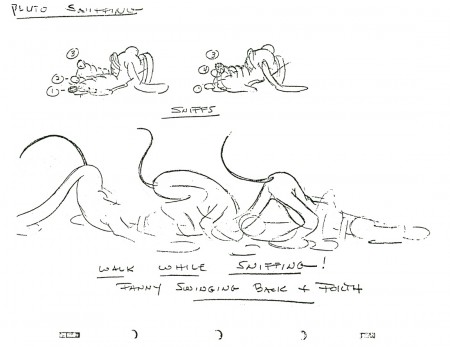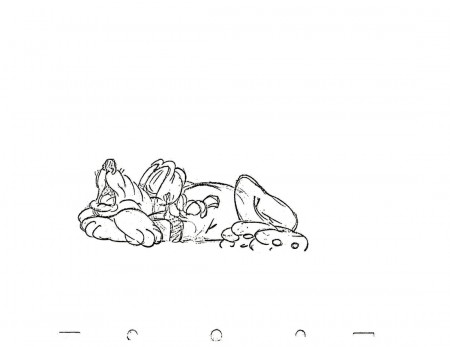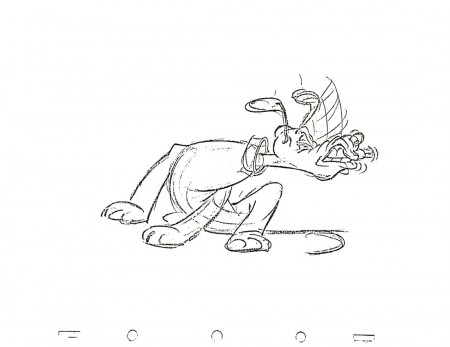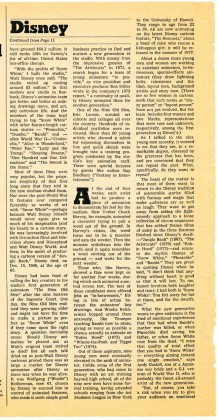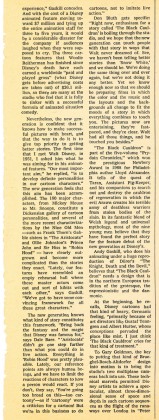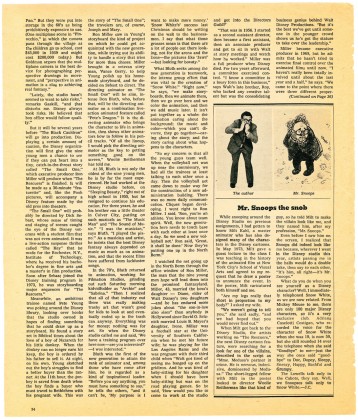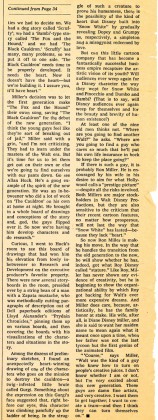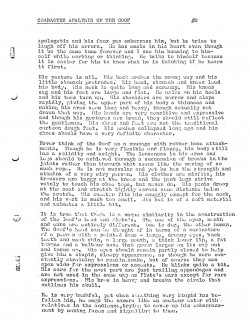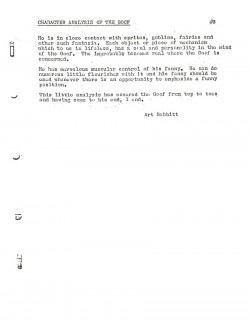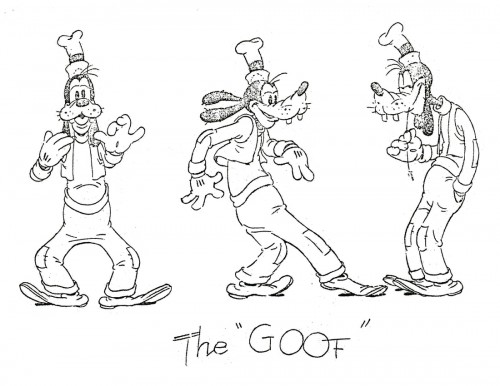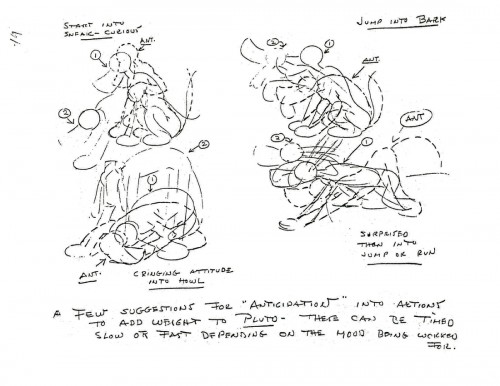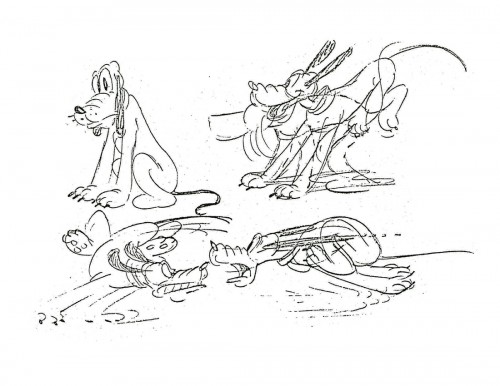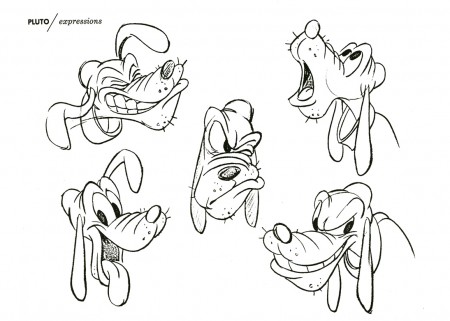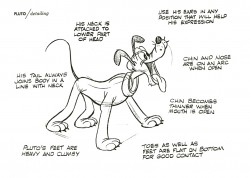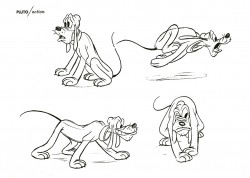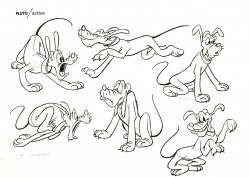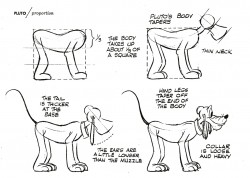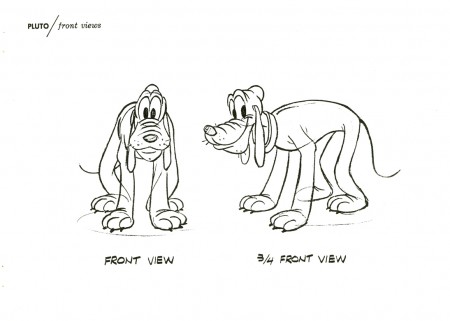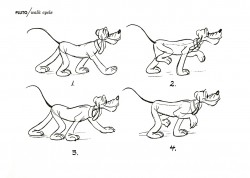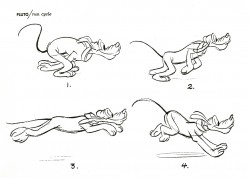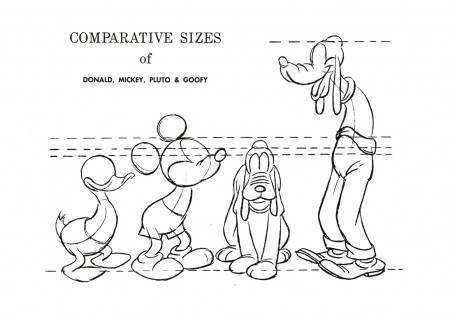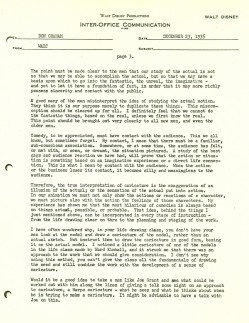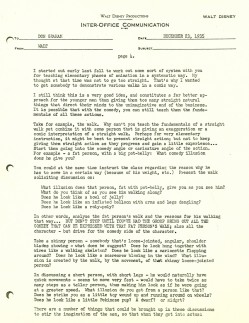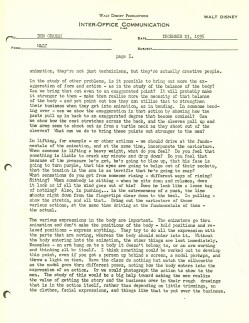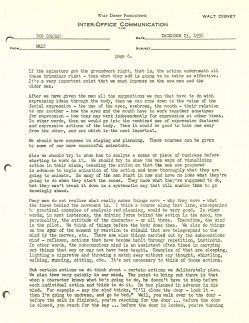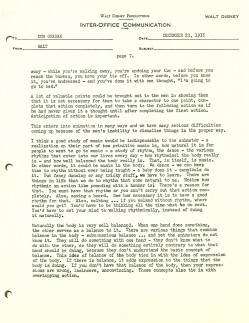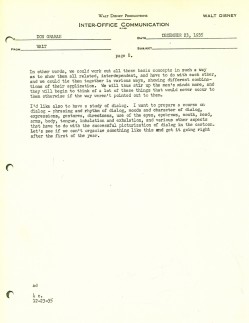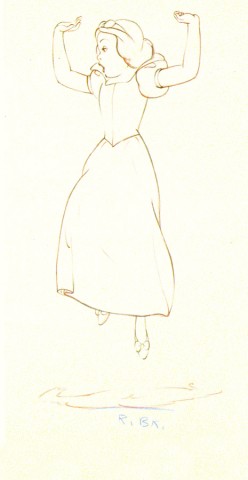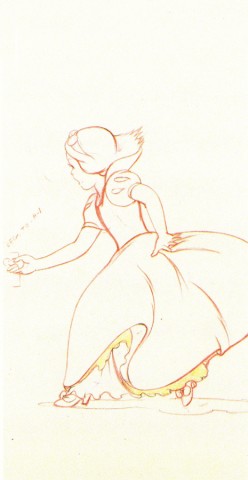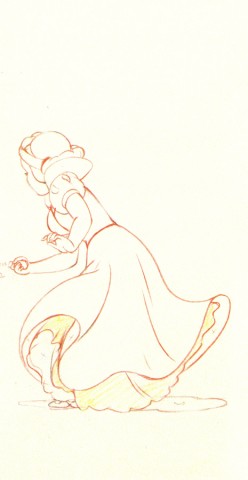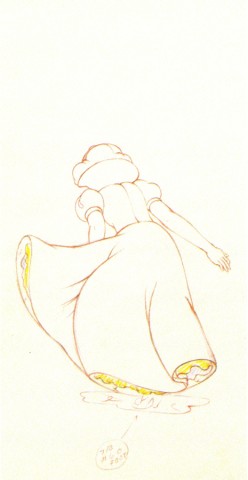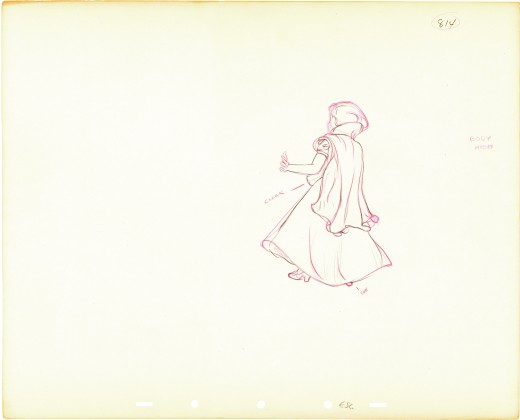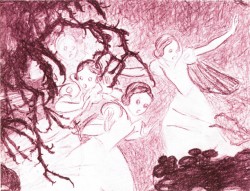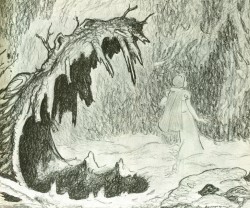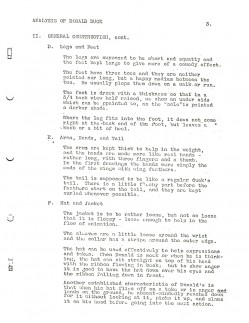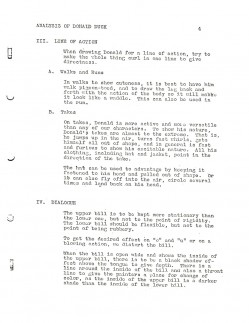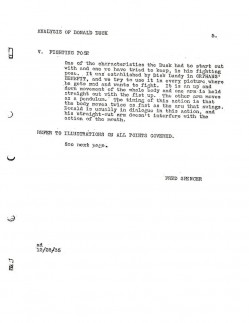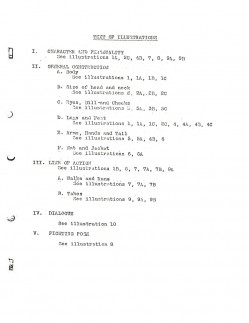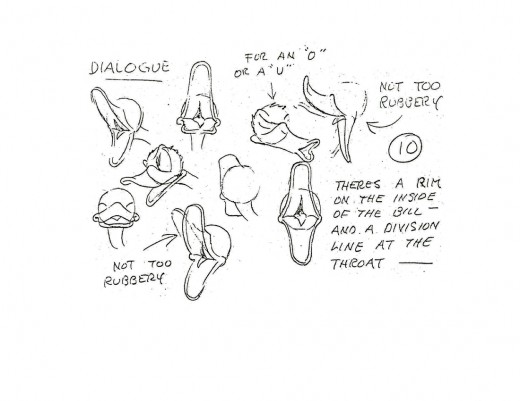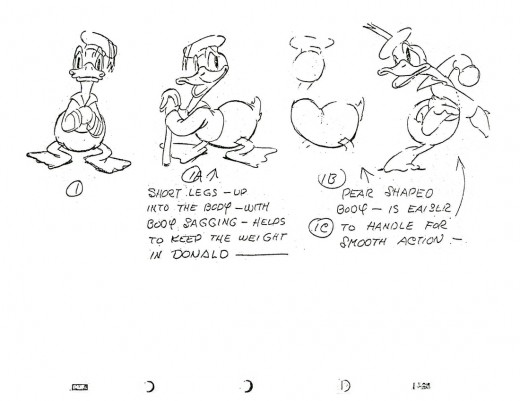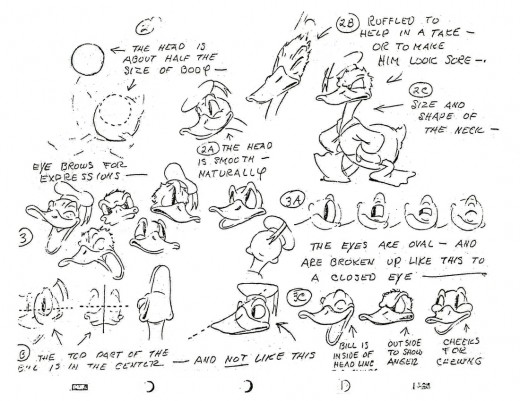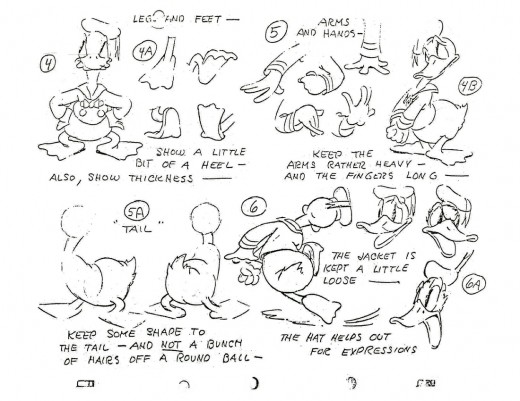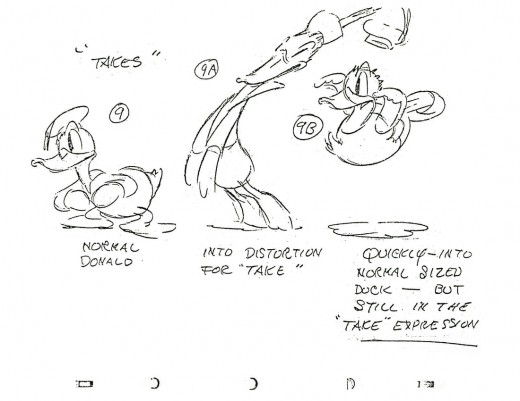Category ArchiveDisney
Animation Artifacts &Disney &Models 07 Aug 2009 08:47 am
How to Draw Mickey
- When last we left off with the Disney lecture series on the principal characters – Mickey, Donald, Goofy, Pluto – I promised to conclude by posting the How To Draw series that were sold at Disneyland (late Fifties/early Sixties).
Go here to see the lecture series posts:
Mickey / Donald / Goofy / Pluto
So to continue with these How to Draw Books, I naturally start with Mickey. I’m not crazy about some of the drawings, but I guess it’s classic. This is actually a copy of the book that they gave out at the Disney/Lincoln Center event in 1973. They’re identical to the Disneyland books, though they lack the colored pages. (See Jenny Lerew‘s great site Blackwing Diaries for the original How to Draw Goofy book.
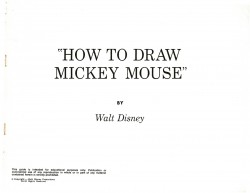 1
1 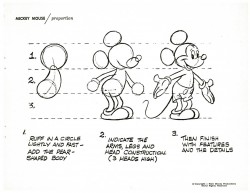 2
2(Click any image to enlarge.)
To put a little more zest into this post, here are a couple of Mickey model sheets I have. (copies of copies)
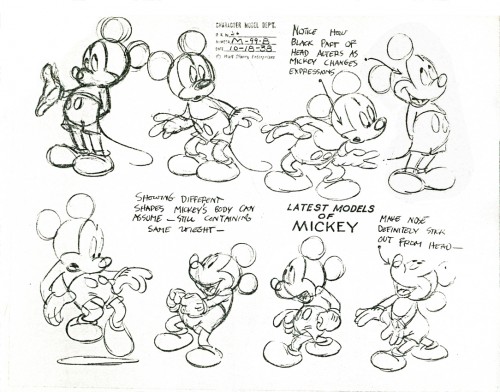
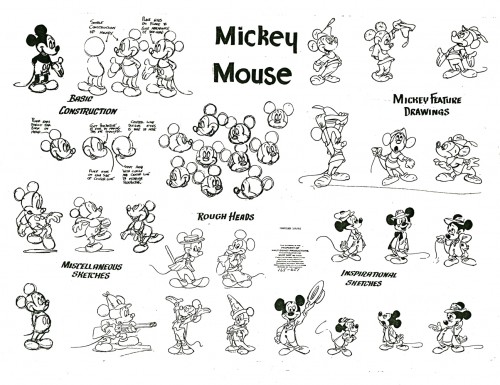
A mixed model with bits from a lot of other sheets.
This was probably put together in the Fifties.
Articles on Animation &Disney 06 Aug 2009 07:10 am
Gilbert Seldes meets Walt Disney
- As a young boy growing up in the far upper reaches of Manhattan I lived for animation. I watched the limited fare offered on television (usually B&W Warner Bros cartoons, the Disneyland TV show on Wednesday nights, early Saturday morning cartoons – Mighty Mouse show being the best of the lot) or I went to the library and to borrow any book I could locate that mentioned the medium.
There were half a dozen books back then, and I probably memorized the lot of them in short time. (I suspect I was the only one borrowing those treasured books.) I remember when I came across a book of collected essays by the film critic, Gilbert Seldes. In this book, The 7 Lively Arts, there was a chapter on Walt Disney. I read and reread it carefully and thoroughly, and I enjoyed it immensely. I’ve recently run into it again (in a different form – he reworked it for the book since that version covers quite a bit more than the very earliest years) in the New Yorker Magazine’s archives. Not bad reading on this rainy day in New York, so I thought I’d share it.
Remember this was written in 1931 when the studio really was just in its earliest phases. Mickey Mouse was barely two years old.
From the Dec. 19, 1931 issue of the magazine:

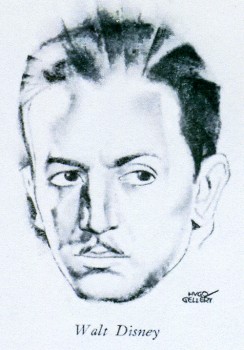 - IN the current American mythology, Mickey Mouse is the imp, the benevolent dwarf of older fables, and like them lie is far more popular than the important gods, heroes, and ogres. Over a hundred prints of each of his adventures are made, and of the fifteen thousand movie houses wired for sound in America, twelve thousand show his pictures. So far he has been deathless, as the demand for the early Mickey Mouses continues although they are nearly four years old; they are used at children’s matinees, for request programs, and as acceptable fillers in programs of short subjects. It is estimated that over a million separate audiences see him every year.
- IN the current American mythology, Mickey Mouse is the imp, the benevolent dwarf of older fables, and like them lie is far more popular than the important gods, heroes, and ogres. Over a hundred prints of each of his adventures are made, and of the fifteen thousand movie houses wired for sound in America, twelve thousand show his pictures. So far he has been deathless, as the demand for the early Mickey Mouses continues although they are nearly four years old; they are used at children’s matinees, for request programs, and as acceptable fillers in programs of short subjects. It is estimated that over a million separate audiences see him every year.
Thirteen Mickey Mouses are made each year. Tin- same workmen produce also thirteen pictures in another series, the Silly Symphonies, so that exactly fourteen days is the working time for each of these masterpieces which Serge Eisenstein, the great Russian director, called, with professional extravagance, America’s most original contribution to culture. The creative, power behind them is a single individual, Walt Disney, who happens to be such a mediocre draughtsman, in comparison with the artists he employs, that he never actually draws Mickey Mouse. He has, however, a drop personal relation to the creature: the speaking voice of Mickey Mouse is the voice of Walt Disney.
HE is a slender, sharp-faced, quietly happy, frequently smiling young man, thirty this month. He is married to Lillian Marie Hounds, whom he met in Hollywood, where she was probably unique, as she had nothing to do with pictures. She has enough to do with them now, because she is the first receiver of her husband’s ideas. Mickey Mouse pictures are talked into being before they are drawn, talked and cackled and groaned and boomed and squeaked and roared and barked and meowed, with ever}- variation of animal sound, with appropriate gesture, and with music. If strange outcries anil queer noises waken Mrs. Disney at night, it is only Walt working on a new story. He never stops; he swims and rides and lie plays baseball with his stall, but all the time he is inventing. He is one of the lucky ones who can make a fortune out of the work the) love and he does not love Mickey for his wealth alone. He was just as keen when exhibitors refused to look at the Mouse, and just as keen over earlier efforts which were, as he now says, “pretty awful.”
He is fortunate also in having as his chief co-worker his elder brother, who is the businessman of the firm. Roy Disney and five assistants attend to finance; Walt and about a hundred others—a quarter of them are artists, the rest are gagmen, story-men, and technical experts— make the picture’. ‘The distribution and sales are in other hands.
When a Mouse or a Silly Symphony is finished, the business side and most of the artists watch it carefully for commercial value, for those mysterious qualities which they think, or guess, will make it popular. They find their congratulations to Walt Disney accepted without enthusiasm. He is not putting on artistic side; he is not indifferent to profits. What he is frequently doing is referring each finished picture back to the clear idea with which it started, the thing he saw and heard in his mind before it ever came to India ink and sound tracks. In the process of making the picture, something often escapes, and Disney wanders moodily away from the projection-room grumbling: “Where did it go to?” and often will begin outlining the original idea again, with gestures and sound effects, to prove that he is right.
THE mechanics of creating Mickey Mouse are complicated and, to the workers, tedious. Six or seven drawings are required for every movement, and the first and last, the position of thr Mouse at the beginning and at the end of any motion, are drawn by the principal artists, or “animators.” After them, the “in-betweeners” fill the intervening space, with minute changes in the figure. The final step in preparing for tin camera is the photographic transfer of these drawings to celluloid. As the background changes less frequently, dozens of celluloid drawings ma)’ be placed over a single background scene.
The drawings are now ready for the camera, which photographs each separately. The tracing of the moving figure is placed on its background, the photograph is taken, and the next drawing is moved into position. About eight hundred photographs can can be taken in one day —- some fifty feet of film.
The sound track is made after the picture has been completed. A short section of the film is projected; the music, which has been selected in advance, is rehearsed by musicians, who watch the screen as they play; and when the timing has been perfected, the music is recorded.
The two advantages of the animated cartoon over the feature picture are only implied in the above description: there are no stars and only *as much film is taken as will be used, A few feet arc allowed for adjustments, but the filming of a hundred and fifty thousand feet for a six-thousand-foot picture does not occur.
WALT DISNEY is, as I have said, thirty, and that means that he is too young to have had a history, too young to have developed oddities and idiosyncrasies. He is a simple person in the sense that everything about him harmonizes with everything else; his work reflects the way he lives, and vice versa. Mickey Mouse appears on the screen with features and Super-specials, but Mickey Mouse is far removed from the usual Hollywood product, with its sex appeal, current interests, personalities, studio intrigue, and the like. And Disney, living” in Hollywood, shares hardly at all in Hollywood’s life. He has not only made a lot of money (between forty and fifty per cent of the return on each film is net profit) better than that, his potential income is enormous: he has the surest bet in filmdom; experts think that he is only at the beginning of his great success. In these circumstances, Hollywood builds itself a palace and a pool; Disney lives in the house he built five years ago when he and his brother were too poor to buy a lot for each, and combined on a corner that both the houses they built would have, sufficient light and air. His house is a six-room bungalow, the commmoner type of middle-class construction in Hollywood; the car he drives is a medium-priced domestic one; his clothes are ordinary. He goes to pictures, but rarely to the flash openings; he neither gives nor attends great parties. Outside of the people who work with him, he has few friends in the industry. The only large sum of money he ever spent was one hundred and twenty-five thousand dollars; it was the cost of his new studio. Everything he earns and everything his brother earns, on the fifty-fifty basis they established years ago, is reinvested in the business.
Walt Disney’s life before he went into movie-making divides into two almost equal and almost entirely un-distinguished section. He was born in Chicago In 1901, his father .was an Irish-Catholic builder and. contractor, his mother a German-American. He went to the Chicago Public. schools and studied drawing for a few months at the Art Institute. Arguing, perhaps, from his present enthusiasms, friends of the Chicago days now say that he was exceptionally fond going to the Zoo. The second period a little shorter in time, is more varied. The family moved to Kansas City; from there Disney, too young for service in the trenches went to the war with a Red Cross unit; fo Kansas City he returned and. tried to become a newspaper cartoonist. He found no job. He went to work as a commercial artist and saved up enough money to make his first animated cartoons.
There were animations of well known fairy tales and children’s classics. In competition with the highly developed product of the experts, they were crude and uninteresting, and they failed. Disney felt that if he wanted to make pictures, he would have to go where pictures were made and, in 1923, departed for Hollywood. His brother, who had come out of the war in shattered health, expected to live only a short time, and thought that California would be an agreeable place for his few remaining months of life. Walt had forty dollars when he arrived in Los Angeles Roy contributed about two hundred and fifty; they borrowed enough to make: a total of five hundred dollars and made their first picture. It was done in a bastard medium, using human beings and drawn figures simultaneously, ordinary movie photography and pen and ink; the inspiration comes from “‘Alice m Wonderland” and the series was called after the heroine which is interesting because – since the success of Mickey Mouse, Disney is continually receiving requests to make the original Alice in his own medium.
The first picture brought in fifteen hundred dollars; half of this was profit, if you figure that the brothers were not entitled to salary. During the making of the picture they had lived skimpily, on one full (cafeteria) meal a day, Roy ordering: the most filling vegetable, Walt the most filling meat, and then sharing, as they shared everything in those days, including their bank account. The lean time was soon over; the pictures were moderately successful, and after about four years, Disney went, in 1927 to Universal, where he created Oswald the Rabbit, the true forerunner of Mickey Mouse. Oswald was left behind when, in the middle of 1928, the Disneys, with fifteen thousand dollars saved, started out again on their own.
Sound was just coming in and Disney’s still-silent cartoons were unacceptable. Instantly he adapted his idea to the new medium. Unlike the producers of feature pictures he had nothing to scrap, no equipment to save, and hardly any public to worry about. He made a drawn comic and took it to New York for synchronisation, When he was finished he took it to the great producers and distributors — the men who had a few months earlier turned down the whole talking mechanism and were now furiously witnessing the success of the Vitaphone, Unanimously they informed Disney that no one would care for animated cartoons with sound. After several weeks, he found an independent backer, and on the nineteenth of September, 1928, the audience at the Colony Theatre in New York was “panicked” by “Steamboat Willie,” the first adventure of Mickey Mouse. A few days later Mickey was the hit at Roxy’s. Almost at once England all-hoiled him. The rest has been roses, roses all the way.
Roses and children. Leaving the distribution of the films to others, the Walt Disney Corporation concentrates commercially on the creation of movie audiences. Disney’s own connection with the vast enterprise which now enrolls three-quarters of a million children in Mickey Mouse clubs is not close. The clubs are the invention of an enterprising member of the business staff, and Disney’s only interest in them is as a source of knowledge; he learns from them what children like. The club members attend morning or early-afternoon performances at movie houses, led by a Chief Mickey Mouse and Chief Minnie Mouse; they have a club yell, and official greeting, a theme song, and a creed. As I find myself a little unsympathetic to this actiity, I sall limit myself to an exact quotation of the creed:
“I will be a square-shooter in my home, in school, on the playground, wherever I may be. I will be truthful and honorable and strive always to make myself a better and more useful little citizen. I will respect my elders and help the aged, the helpless, and children smaller than myself. In short, I will be a good American.”
For the good Americans there are commercial tie-ups with local businessmen, such as druggists who may feature a Mickey Mouse sundae, florists with Mickey Mouse bouquets, and so on; Parent-Teacher Associations are enlisted; the films at the matinees are swift-moving Westerns and other clean films, with a rather elaborate ritual of patriotism and good-fellowhip before and after.
It was reported that at the great Leipzig Trade Fair this year, forty percent of all the novelties offered were inspired by Mickey Mouse. One American company lists a velvet doll, a wood-jointed figure, a mechanical drummer, a metal sparkler, and half-a-dozen oter toys; there is a “Mickey Mouse Coloring Book” and another book of the adventures of Mickey Mouse; you can have Mickey Mouse on your writing paper; you can have him as a radiator cap. He appears in a comic strip in twenty-seven languages. From all of these exploitations, the originators receive royalties, since the own both the name and the design of the figure. (Infringements have been successfully prosecuted.) On the screen, Mickey Mouse appears in every country to which equipment for projecting sound films has penetrated. His name in Japan is Miki Kuchi.
Neither at homr nor abroad has Mickey’s career been without accidents. In Germany the appearance of an army of animals in Uhlan helmets was considered an affront, and the film was censored. In more dainty Ohio a cartoon was barred because a cow was discovered reading “Three Weeks.” Cows seem to have given more offence than any other beast in the Disney jungle, for many State Boards of Censorship protested against the grotesque and emotionally expressive udders which Nature and Disney gave them, and hereafter udders are to be at least partially concealed under a small provocative skirt. Disney himself is amused by the fuss; quite justifiably he takes it as a tribute to the remarkable reality of his totally unreal figure.
The process of creating this unreality begins in Disney’s mind. By this time it is only necessary for him to think of Mickey running to a fire, or Mickey skating; the rest is worked out in discussions with the artists and the gagmen. The automatic thing, the formula of the present, is the creative work of years ago, when Disney saw a series of pictures, saw moving forms across landscapes, rhythmic dances, compositions in black and white. These are still the essence of his pictures; his imagination is still largely visual. Only now that his assistants know the kind of picture he wants, his work has to he selecting the general idea, thinking out the tiny plot (even if it be only a modern version of “Little Red Riding Hood’* or a burlesque of some popular feature film), leaving the rest to experts.
I HAVE kept Mickey Mouse in the foreground because in general it is with Mickey that Disney is identified; but I belong to the heretical sect which considers the Silly Symphonies by far the greater of Disney’s products. Although there is a theme in each one, DISNEY’S IMAGINATION is freer to roam than it is in the more formal Mouse series. The Symphonies, moreover, are true sound pictures, without dialogue; the Mouse series has a tendency, lately, to run to verbal fun which is a little out of place.
Unlike the Mouse pictures, the Symphonies have no central character and no clearly defined plot. In them the animals and vegetation, purely incidental to Mickey Mouse, are brought into the foreground, and go through a wide range of activity — dances, skating contests, and so on — to the accompaniment of a reiterated musical theme.
The Symphonies reinforce what the Mouse tells us about Disney’s character: his delight in quick surprises, his uncomplicated sense of fun, his keen observation (Mickey Mouse has, correctly, four fingers, (not five). In addition they suggest his passion for all animals—he dropped his work and ran all over the vacant lot near his studio when he heard that a gopher snake had been seen there; he watched some sparrows for hours while they bent off a hawk and set up their nest. And he likes enormously the kind of laughter he himself creates; laughter at absurdities and impossibilities. Out of these natural, simple interests, backed by enormous files of pictures, cross-sections, and data on every animal extant, he creates the Silly Symphonies.
Like the first Mouse, the first Silly Symphony was long rejected by exhibitors; once shown, it ran six weeks at one house, an exceptional occurrence for a short subject. It was the Skeleton Dance, a theme naturally macabre, but treated with such humor and fantasy that no child has ever been frightened by it. Soon after followed a masterly series on the four seasons.
In one of these occurs a moment typical of Disney’s method. A frog dances on a log, its shadow following in the pool below. Presntly the frog moves to the opposite end of the picture, the shadow stays where it is, but continues to reflect the dance; then it joins its owner. Perhaps fifteen seconds cover the incident; it is a gracenote of wit over the broad humorous symphony of the whole picture.
With a picture to make every two weeks, both Disney and his associates have to use certain formulas, like the dancing of animals and chairs, chases and the sudden elongations of necks and legs. But the freshness of picture after picture proves that the creative force behind the formula is still powerful, and the combination of ingenuity and innocence (which was typical of prewar America) can still give pleasure. At the end of three and a half years, Disney’s ingenuity seems more fertile than ever. And his innocence is attested by the fact that he can think of nothing better to do with his time, his talent, and the five thousand a week (or thereabouts) which he earns, tan to put all of them back into the work he enjoys.
- Gilbert Seldes
Books &Disney &Illustration 05 Aug 2009 07:18 am
Three Little Kittens book
- I’ve often been curious about the generation that lived through the late 30′s early 40′s. The animated cartoons that were made during this roughly six year period often feature enormously cute characters going through cute storylines. The audiences must have loved it considering the fact that there are so many of these films, including Oscar nominees and winners.
Lend A Paw, The Milky Way, Merbabies, Wynken Blynken and Nod, Two Little Pups, and any of the Sniffles cartoons all featured good animation and high prduction values but terminally cute material.
The Three Orphan Kittens of 1935 was an Oscar winner and as cute as all getout. Not only are these mischievous kittens, but they’re also orphans. The film was directed by David Hand and featured a seuquence by Ken Anderson in which floorboards were animated to try to capture the illusion of 3D.
A number of children’s books were produced from this material, and I offer here the illustrations from one smaller-sized book. It was originally published in 1935 and was obviously such a success that it was reprinted in 1949.
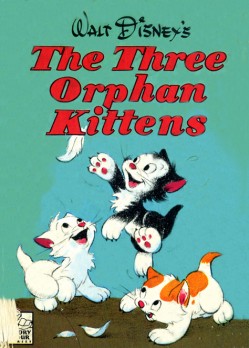
(Click any image to enlarge.)
Here are a couple of preproduction drawings done for the film.
It’s interesting to compare this material with the excellent shorts by Simon Tofield featuring Simon’s Cat. Both utilize pet cats as the featured star; both are lightyears apart from each other. They’re both representative of their time. Two different kinds of cuteness. One works today.
Daily post &Disney &Music &UPA 31 Jul 2009 07:16 am
Animation Music
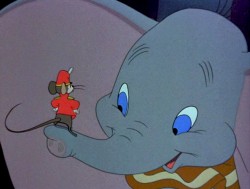 - There’s an extensive review of the music for the Disney animated features, from Dumbo on up through the Fifties. The article was written by Ross Care who is a composer and a film music historian specializing in animation. This was originally written for Cinemascore and can be found on their site – here.
- There’s an extensive review of the music for the Disney animated features, from Dumbo on up through the Fifties. The article was written by Ross Care who is a composer and a film music historian specializing in animation. This was originally written for Cinemascore and can be found on their site – here.
The article gives reports on the music of composers Oliver Wallace, Paul Smith, Ed Plumb and Charles Wolcott. It talks about Dumbo and the post Dumbo features: Victory Through Air Power, Saludos Amigos, and The Three Caballeros. Make Mine Music, Melody Time, Song Of The South, So Dear To My Heart, Fun And Fancy Free, Ichabod And Mr. Toad as well as Cinderella, Peter Pan and Alice in Wonderland.
If you have any interest in the history of film music, particularly applicable to the Disney films, this is worth reading.
- Here’s a review of the film music of UPA written back in the Fifties for Films In Review magazine. I don’t have the exact date of this article I’d saved for the past thirty years.
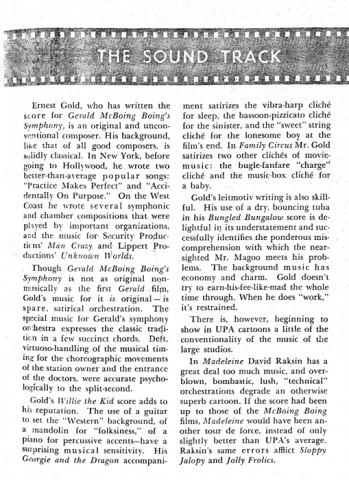 1
1 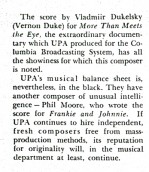 2
2(Click any image to enlarge.)
Animation Artifacts &Articles on Animation &Disney 29 Jul 2009 07:47 am
Pluto models
 - When I posted the Goofy model notes I thought that I’d finished posting all that I had. Well I’ve just come up with this series of excellent lecture notes on drawing Pluto and his character. Ted Sears leads us to Norm Ferguson, who was the promary speaker for this lecture given to the Disney animation group back in 1936. They gave up drawing these characters so beautifully way back in the Thirties.
- When I posted the Goofy model notes I thought that I’d finished posting all that I had. Well I’ve just come up with this series of excellent lecture notes on drawing Pluto and his character. Ted Sears leads us to Norm Ferguson, who was the promary speaker for this lecture given to the Disney animation group back in 1936. They gave up drawing these characters so beautifully way back in the Thirties.
These finish off the character analysis lecture notes I have. You can find those for Mickey, Donald and Goofy elsewhere on this blog.
An edited form of these notes were published in Frank Thomas & Ollie Johnston‘s The Illusion of Life.
Here are the Pluto notes:
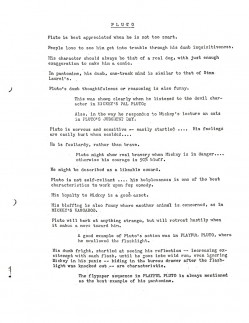 1
1 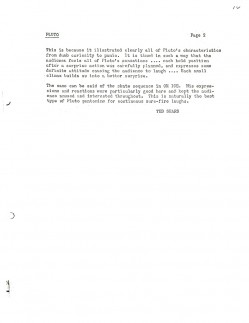 2
2(Click any image to enlarge.)
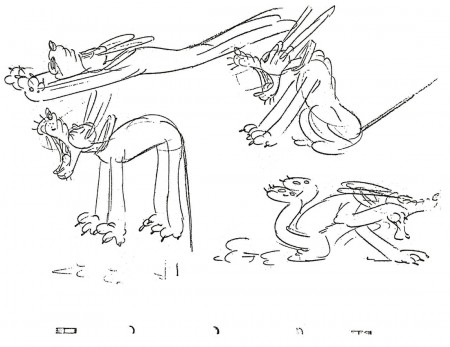 5
5
These drawings just never made it to the How to Draw Pluto
book that they sold at Disneyland in the Fifties.
Too much raw life and funny pictures.
All that’s left is for me to post the How to Draw Mickey and How to Draw Donald books from the Art Center at Disneyland. Next week.
Articles on Animation &Disney 28 Jul 2009 07:42 am
Old Black Magic
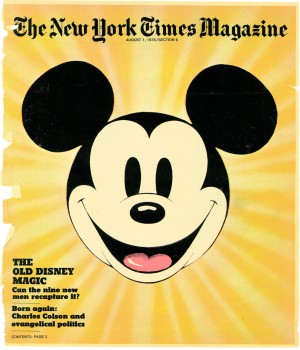 - Back in 1979, an eruption took place at the Disney studio. A group of the younger, talented artists at the studio – 20 of them – decided they couldn’t put up with it anymore and they walked out of the studio. Led by Don Bluth, they moved into his garage and a new studio came into being with competition for Disney’s troubled animation department.
- Back in 1979, an eruption took place at the Disney studio. A group of the younger, talented artists at the studio – 20 of them – decided they couldn’t put up with it anymore and they walked out of the studio. Led by Don Bluth, they moved into his garage and a new studio came into being with competition for Disney’s troubled animation department.
The rebellion didn’t just happen. Foment had started years earlier as Disney produced films such as The Black Cauldron, Pete’s Dragon and The Small One. Together with John Pomeroy and Gary Goldman, Bluth had put together an idea for a trial film, Banjo the Woodpile Cat, in 1975. The three got together after-hours and worked on their pilot film.
The article by John Culhane that appeared in the 1976 NYTimes really got this small group going. Disney was trying to put a little kick in their animation studio, and the kick ultimately resulted in a new animation studio – which, ironically, helped to get Disney back on track. It also got a couple of other studios going – Amblin and Ted Turner. They proved that there was money to be made in animation and slowly studios grew.
Here’s that NYTimes Magazine article:
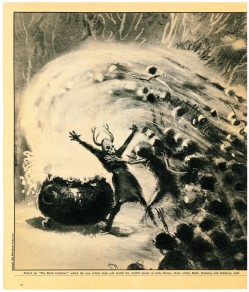 1
1 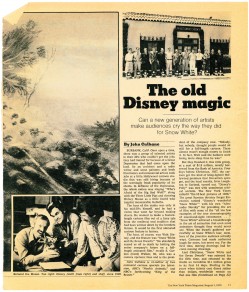 2
2(Click any page to enlarge to a readable size.)
In April, I wrote about Bluth and Banjo in two parts:
Part 1
Part 2
Articles on Animation &Books &Disney &Models 20 Jul 2009 07:21 am
Goofy/Pluto models
- I’ve recently posted some discussions about Mickey and Donald which were part of the extrawork courses that the Disney studio held in the Thirties. Go here to see Mickey, go here to see Donald.
Here’s the section on the “Goof” which also includes a couple of Pluto models.
Art Babbitt is the lecturer.
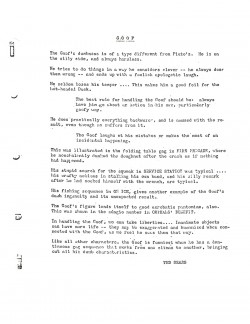 1
1 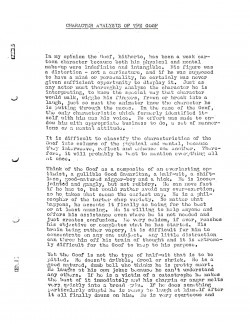 2
2(Click any image to enlarge.)
Since there were so few pages to the above document, I thought I’d add the pages of the How to Draw Pluto book which was part of the Disney Animation Kit you once could buy from the Art Corner at Disneyland. It included books on How to Draw Mickey, Donald, Goofy and Pluto as well as a book on Tips in Animation.
Here’s Pluto:
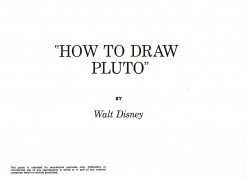 1
1 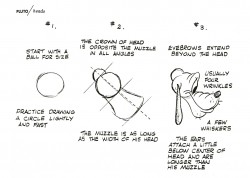 2
2
Animation Artifacts &Disney 15 Jul 2009 07:21 am
Walt-Graham communique
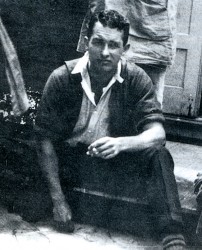 - By 1935, Walt Disney had realized where he had to take his studio. Principal to the plans he had was the education of the artists within his studio.
- By 1935, Walt Disney had realized where he had to take his studio. Principal to the plans he had was the education of the artists within his studio.
At this time, a number of students were wending their way from Chouinard Art Institute to the Disney employ. In 1935, there was a large gathering of teachers from Chouinard who came to the Disney Studio one evening to see the environment and start to mold a union between the school and the studio. Disney offered a catered meal for the event.
The studio became permanently linked with Chouinard, which eventually became Cal Arts. Disney stayed in close contact with a number of instructors and selected an obvious choice for the large task of helping to educate those within his studio. _____________________Don Graham
He planned a night course several days a week in which Don Graham would lead and he would involve a number of key designers and animators in instructing within the studio.
Prior to the start of classes, Disney wrote a long letter to Graham to discuss what he hoped would be taught. Here’s that letter:
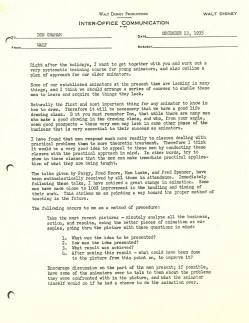 1
1 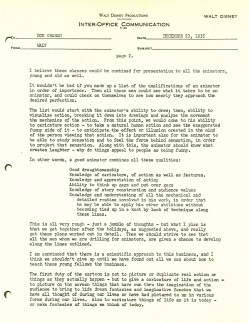 2
2
Animation Artifacts &Books &Disney 14 Jul 2009 07:39 am
Snow White drawing
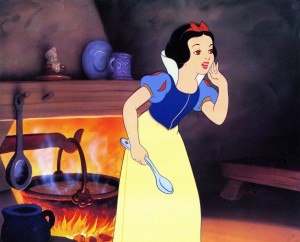 - This past week I bought an inexpensive drawing on e-bay. I wondered why no one else had bid on it. The drawing was a little rough of Snow White. Regardless I got it and continued to wonder about it.
- This past week I bought an inexpensive drawing on e-bay. I wondered why no one else had bid on it. The drawing was a little rough of Snow White. Regardless I got it and continued to wonder about it.
I scanned through John Canemaker‘s wonderful book, Treasures of Disney Animation Art. Lo and Behold there were some other drawings of Snow White, and it was obvious that the same artist had drawn them, Jack Cutting.
The drawings in the book show a short piece that was cut from the film, the soup eating scene. Snow White realizes the soup is boiling over, jumps in a turn and runs back to the pot.
These are the six drawings John includes:
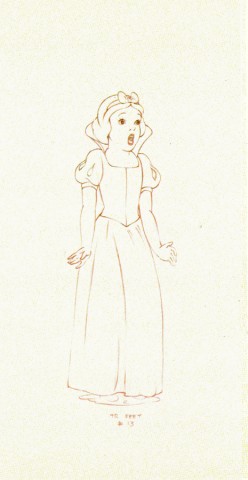 1
1 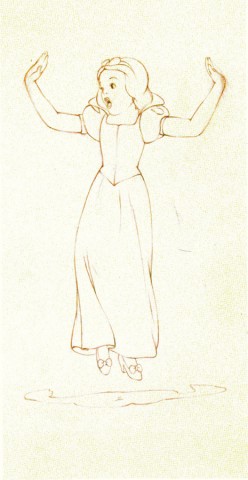 2
2(Click any image to enlarge.)
Here’s the drawing I just bought, which seems a bit more rough than the others. In all other aspects it looks similar, and the handwriting on the drawing matches those in the Canemaker book.
Of course, it might be the work of an inbetweener. The tentative numbers and the tentative fingers make me think it might be so. However, the drawings are clean over rough, which is not likely something an inbetweener would do. (Perhaps an overconfident one.) Regardless, I’m happy to have it. At first I thought the drawing came from the sequence where Snow White is running from the hunter into the deep dark woods.
But looking a little closer, it seems to be part of the animals pulling Snow White to the dwarfs’ cottage. This frame grab was the closest I’d gotten. My drawing is obviously a rough (what they call in NY, a clean-rough. Meaning the animator worked clean.) Obviously the assistant pulled it together for the scene.
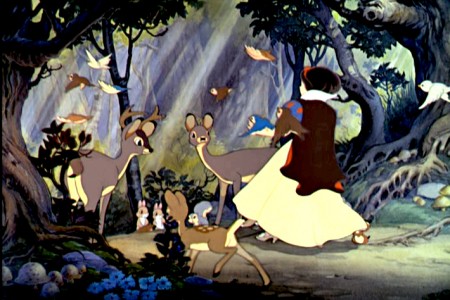
You’ve gotta love animation.
Animation &Animation Artifacts &Articles on Animation &Disney &Models 13 Jul 2009 07:31 am
Donald Models
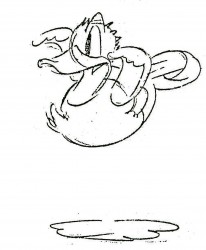 - A few weeks ago I posted the handout sheets that were given at Disney’s in 1938 to advise people on how to draw Mickey. The same was done for Donald, Goofy and Pluto.
- A few weeks ago I posted the handout sheets that were given at Disney’s in 1938 to advise people on how to draw Mickey. The same was done for Donald, Goofy and Pluto.
Here are the notes from the Fred Spencer class analyzing Donald Duck. There’s a lot here that even the Disney studio sees to have forgotten about the Duck. He’s a brilliant and unique character, and he hasn’t been done as well as he was drawn in the 30s.
These same notes appeared in a synthesized and cleaned-up form in Frank Thomas Ollie Johnston’s Illusions of Life. Somehow I prefer the slightly browning mimeo sheets from the studio. (Although mine are just a xerox of same.) These are all worth it for the incredible drawings on the last page.
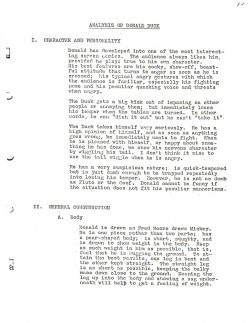 1
1 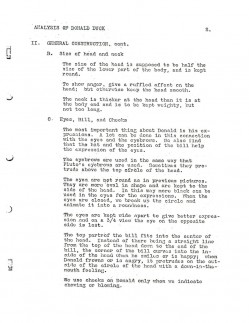 2
2(Click any image to enlarge.)
You can see what the actual pieces look like at Didier Ghez’ Disney History site. He posts two pages courtesy of Gunnar Andreassen.
